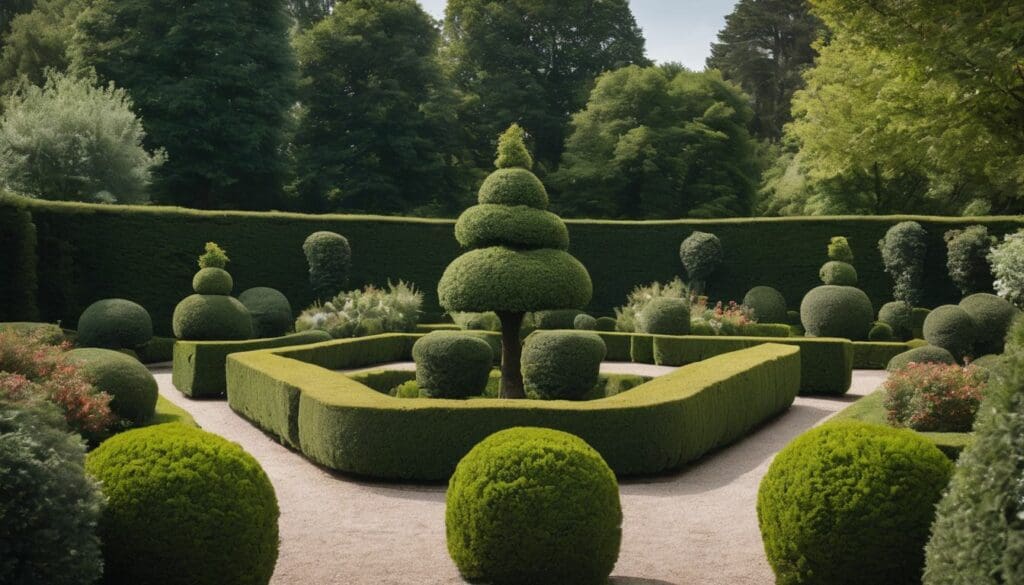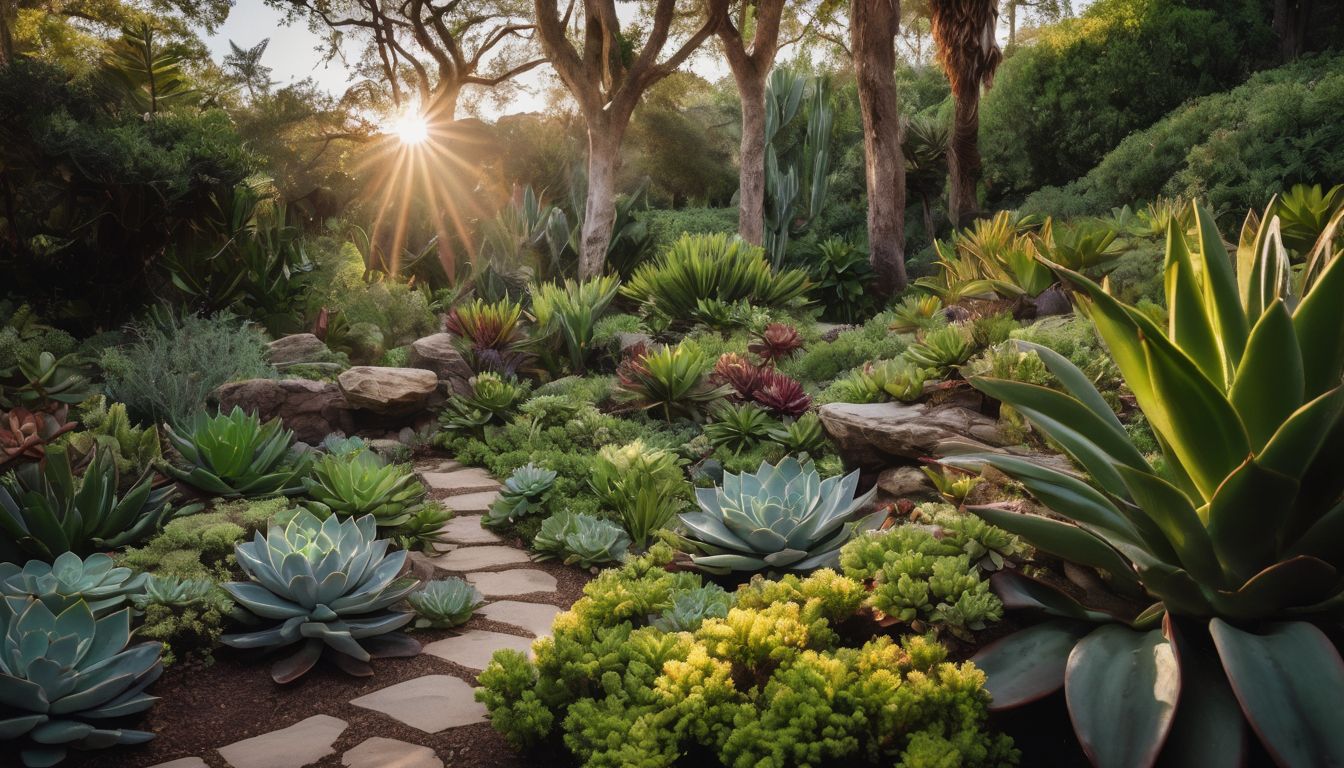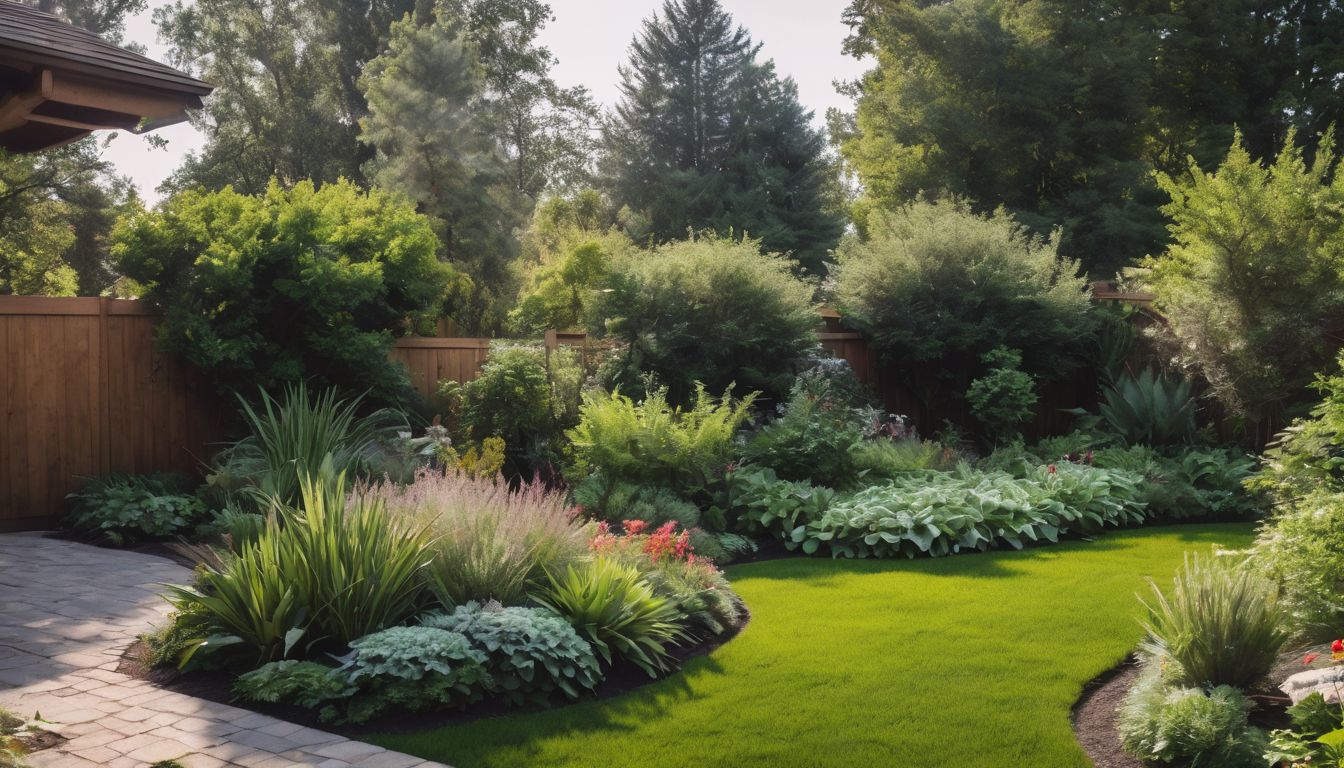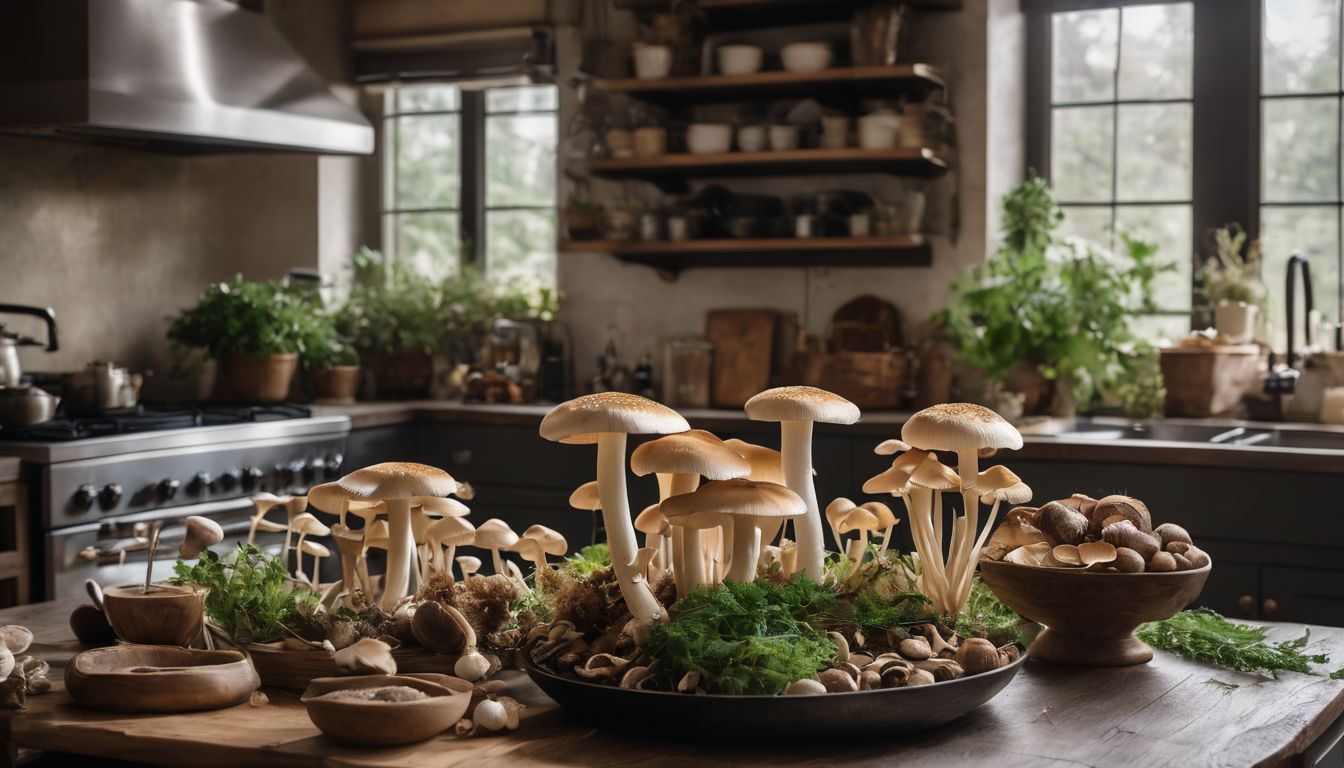Is your garden looking rather ordinary, longing for a touch of creativity? Topiary, the ancient art of sculpting plants into intricate shapes, dates back to Roman times and has beautified gardens for centuries.
This guide will equip you with simple techniques and projects to transform your green space into a living sculpture gallery. Dive in and let’s shape up your gardening game!
Key Takeaways
- Topiary is an ancient practice dating back to Roman times, involving the shaping of plants into geometric or decorative designs using tools such as pruning shears and hedge trimmers.
- Beginners can start with simple topiary projects like cones, balls, or spirals using readily available plants like boxwood, yew, or holly and basic gardening tools.
- It’s essential to regularly maintain topiaries by pruning, fertilising appropriately for plant health and managing pests and diseases organically when possible.
- Advanced techniques include using frames for intricate shapes and combining topiary with other elements in the garden for a unique aesthetic appeal.
- Topiary not only enhances gardens visually but also supports environmental sustainability by providing habitats for wildlife.
What is Topiary?
Topiary is the art of shaping and clipping plants into geometric or free-form designs. It has a long history dating back to ancient Rome and has evolved into various types such as formal, informal, and landscape topiary.
Definition
Topiary is the art of sculpting plants into defined shapes and designs. Skilled gardeners meticulously clip and train shrubs and trees to form geometric shapes, intricate figures, or even detailed animal sculptures.
This greenery art transforms gardens into expressive landscapes, combining nature with human creativity.
The practice relies heavily on patience as it involves guiding plants’ growth through continuous pruning and training. Topiary gardening techniques make use of ornamental plants like boxwood, yew, and privet due to their dense foliage which lends itself well to precise shaping.
The careful clipping not only creates visual pleasure but also promotes healthy plant growth by removing dead or excess branches.
History
Topiary has a rich history dating back to ancient Rome, where it was popularised in elaborate gardens. During the Renaissance, topiary gained prominence in Europe and became associated with grand estates and formal gardens.
The art of sculpting plants into shapes and figures continued to flourish over the centuries, with different cultures contributing their own unique styles and techniques. Topiary has evolved from simple geometric forms to intricate animal and human figures, showcasing the creativity and skill of gardeners throughout history.
The tradition of topiary continues to inspire modern gardening enthusiasts, offering a timeless connection to nature while providing an opportunity for artistic expression. Incorporating natural elements into designed landscapes is not only aesthetically pleasing but also promotes environmental sustainability by creating habitats for wildlife and preserving green spaces.
As we explore the fascinating history of topiary, it becomes apparent that this art form holds enduring appeal for those seeking to cultivate both beauty and harmony within their surroundings.
Types of Topiary
Topiary comes in various forms, each offering unique visual appeal to your garden. Different types include geometric shapes such as cones and balls, as well as more freeform designs like spirals and arches.
How to Get Started with Topiary
To get started with topiary, begin by choosing the right plants for your project. Consider the size and shape of the plant as well as its growth habits. You will also need basic tools such as pruning shears, hedge clippers, and shaping templates to help you achieve your desired look.
Choosing the Right Plants
Select plants that are well-suited to the climate and soil conditions of your area. Consider using traditional topiary plants such as boxwood, yew, or holly. Opt for plants with small leaves which are easier to shape and maintain. Look for disease-resistant varieties to reduce the need for chemical interventions. Choose plants that will grow well in the available sunlight and space in your garden. Reach out to local nurseries for advice on the best plant options for your region.
Tools and Materials Needed
After choosing the right plants for your topiary project, it’s essential to have the necessary tools and materials. Here’s what you’ll need:
- Pruning Shears: These are essential for precise cutting and shaping of foliage.
- Hedge Trimmers: Ideal for maintaining the shape of larger shrubs and hedges.
- Topiary Frames: If you plan to create intricate shapes, frames will help guide the growth of your plants.
- Gloves: Protect your hands while working with thorny or sharp-edged plants.
- Soil and Fertiliser: Ensure your plants have the nutrients they need to thrive.
- Watering Can: Keeping your topiary well-hydrated is crucial for healthy growth.
- Mulch: Helps retain moisture in the soil and suppresses weed growth.
Techniques for Shaping and Clipping
When shaping and clipping topiary, start by choosing the right tools. Use sharp shears for precision and a hedge trimmer for larger areas. Begin by pruning the plant to remove any dead or overgrown branches.
Trim carefully around the edges, following the desired shape or pattern. To maintain topiary forms such as cones, balls, or spirals, regularly clip new growth to retain their defined shape.
Remember proper positioning is crucial when trimming plants into specific designs; make sure you step back periodically to assess your progress.
Beginner-Friendly Topiary Projects
Get started with simple shapes like cones, balls, and spirals, or try your hand at creating freehand figures to add a personal touch to your garden. Ready for more? Read on to discover how you can take your topiary skills to the next level!
Creating Simple Shapes (cones, balls, spirals)
To create simple topiary shapes, you can start with plants such as boxwood, yew, or holly. These evergreen shrubs are ideal for shaping into cones, balls, and spirals using basic hand tools like shears and secateurs. Here’s how you can transform your shrubs into beautiful topiary designs:
- Cones: Begin by gently pruning the sides of the shrub and gradually shaping it into a conical form. You can use string to help guide your cutting if needed.
- Balls: Trim the shrub into a round shape by carefully removing excess foliage, ensuring an even and balanced appearance.
- Spirals: Create visually stunning spirals by carefully twisting and trimming the branches around a central point. It’s important to maintain uniformity while shaping the spiral for an elegant look.
Making Freehand Figures
After mastering the art of creating simple shapes like cones, balls, and spirals, you can move on to making freehand figures. This allows for more creative expression and a personalised touch. Here are some tips for creating freehand figures:
- Begin with a clear vision of the figure you want to create, whether it’s an animal, person, or abstract design.
- Use pruning shears to carefully trim the foliage, shaping it gradually to form your desired figure.
- Step back periodically to assess your progress from different angles and make necessary adjustments.
- Consider using topiary frames as a guide for intricate designs, helping you achieve more precise shapes.
- Incorporate elements of symmetry and balance in your design to create visually appealing freehand figures.
- Remember to maintain the health of the plant by avoiding over – pruning while sculpting intricate details.
- Experiment with different plants and their growth patterns to explore diverse possibilities for freehand figures in your garden.
Training an Arch
To train an arch in topiary, start with selecting flexible plants like yew or box. These are ideal for shaping into arches due to their pliable branches and ability to withstand regular pruning.
- Choose young, healthy plants that are about 60 – 90 centimetres tall. They should have long, flexible branches that can be gently bent into the desired arch shape without breaking.
- Use soft garden twine to guide the growth of the branches along a curved frame or structure. This will help encourage the plant to grow in the desired arch shape over time.
- Regularly prune and trim the new growth to maintain the arch shape and promote denser foliage along the arched structure.
- Fertilise the plants during their growing season to ensure they remain healthy and vibrant, supporting their vigorous growth and maintaining a lush appearance.
- Protect your trained arch from pests and diseases by regularly inspecting the plant, removing any infected foliage, and using organic pest control methods if necessary.
- During winter, shield your arch from frost by covering it with horticultural fleece or burlap to protect it from extreme cold conditions, ensuring its survival through harsh weather.
Taming a Hedge
Taming a hedge involves careful shaping and maintenance to create a neat and sculpted appearance. Here are the steps involved in taming a hedge:
- Selecting the right hedge plants: Choose dense, evergreen plants such as boxwood or yew for a classic formal look.
- Trimming techniques: Regularly trim the sides and top of the hedge to maintain its shape using sharp shears or a powered trimmer.
- Creating smooth lines: Use a taut string as a guide to maintain an even line while trimming for a polished finish.
- Preventing overgrowth: Prune the hedge regularly to prevent it from becoming too thick or sprawling beyond its intended boundaries.
- Encouraging bushy growth: Periodically pinch back new growth to encourage the development of lush foliage throughout the entire hedge.
- Fertilising for healthy growth: Apply a balanced fertiliser in spring to promote healthy foliage and vigorous growth.
Maintaining Your Topiary
Once you’ve shaped your topiary, it’s important to keep up with regular pruning and trimming to maintain its form. Fertilise as needed, keep an eye out for pests and disease, and protect your topiary from harsh winter weather.
Pruning and Trimming
To maintain the shape and health of your topiary, follow these steps:
- Start by using clean, sharp pruning shears to carefully trim away any excess growth. This allows you to maintain the intended shape and size of your topiary.
- Regularly inspect your topiary for any damaged or diseased foliage, and promptly remove any affected parts with your pruning shears. This helps to prevent the spread of disease and keeps your topiary looking its best.
- Use scissors or fine-tipped pruners to carry out detailed trimming around intricate areas of your topiary. This meticulous approach ensures that every part of your sculpture looks neat and well-defined.
- After each trimming session, step back and assess the overall appearance of your topiary from different angles to identify any areas that may need further attention.
- Finally, dispose of the clippings responsibly and consider composting them if possible, reducing waste and supporting environmental conservation efforts in your garden.
Fertilising
To keep your topiary looking healthy and vibrant, it is essential to fertilise the plants regularly. Choose a balanced, slow-release fertiliser to provide the necessary nutrients for optimal growth without overstimulating the foliage or causing excessive growth.
Apply the fertiliser according to the package instructions, making sure not to overdo it as this can harm your plants. Additionally, consider using organic fertilisers such as compost or fish emulsion to support sustainable gardening practices and help maintain a healthy ecosystem in your garden.
By routinely fertilising your topiary, you are ensuring that your sculpted shrubs receive the essential nutrients they need for sustained growth and lush greenery. Properly nourished plants will not only look beautiful but also contribute positively to the overall environmental balance of your garden space.
Pest and Disease Control
To keep your topiary healthy, inspect plants regularly for any signs of pests or diseases. Look out for common issues such as aphids, spider mites, and powdery mildew. Treat problems promptly with organic pest control solutions to avoid harming beneficial insects or wildlife in your garden.
Additionally, maintaining good air circulation around your topiary can help prevent disease by reducing the likelihood of fungal infections. Regularly remove fallen leaves and debris from around your plants to create an environment less conducive to pests and diseases.
After ensuring that your topiary is well-protected against pests and diseases, it’s time to focus on another essential aspect – protecting topiary in winter.
Protecting Topiary in Winter
During the winter season, it is vital to protect your topiary from harsh weather conditions. Insulate smaller topiaries with hessian or horticultural fleece to shield them from freezing temperatures and strong winds.
Mulching around the base of larger topiaries can help regulate soil temperature and retain moisture, providing essential protection during colder months. Additionally, consider moving potted topiaries indoors or into a sheltered area to safeguard them from frost.
To maintain the health and structural integrity of your beloved topiary in winter, take proactive measures such as insulating, mulching, and relocating as needed. These protective steps will ensure that your carefully sculpted plants emerge unscathed when spring arrives.
Tips and Inspiration for Taking Your Topiary to the Next Level
Learn how to use topiary frames to create intricate shapes, explore combining topiary with other gardening elements for a unique look, and master advanced shaping techniques. Get inspired by showcasing your topiary in different settings, from formal gardens to modern landscapes.
Using Topiary Frames
Topiary frames are metal or wire structures that guide the growth of plants into specific shapes.
- Enhancing Creativity: Topiary frames allow you to unleash your creativity by sculpting plants into captivating forms.
- Variety of Designs: You can find a wide range of topiary frames in different sizes and styles to suit your gardening vision.
- Flexibility: Frames can be used with various types of plants, offering flexibility in creating unique topiary designs.
- Long-lasting Impact: Once the plant grows and adheres to the frame, it will maintain its desired shape for a long time.
- Eye-catching Focal Points: Use frames to create stunning focal points in your garden or outdoor spaces, adding visual interest and charm.
- Sustainable Gardening: By using topiary frames, you can incorporate sustainable gardening practices whilst adding artistic flair to your green spaces.
- Unique Artistic Expression: Explore the potential of combining natural elements with artistic expression through topiary frame designs.
Combining Topiary with Other Gardening Elements
Enhance your garden by integrating topiary with other gardening elements. Try incorporating topiary into floral arrangements for a unique visual impact.
- Use topiary as focal points within flower beds to add height and structure to your garden design
- Pair topiary with ornamental grasses to create a natural and textured look
- Integrate topiary into vegetable gardens as functional art, providing aesthetic appeal while also promoting sustainability
- Combine topiary with water features such as fountains or ponds for a tranquil and harmonious landscape
Advanced Shaping Techniques
Level up your topiary skills with advanced shaping techniques. Experiment with intricate designs and detailed forms using specialised topiary shears and wire frames. Refine your clipping finesse to sculpt animals, geometric shapes, or even people from your plant foliage.
Elevate your garden to an artistic masterpiece by incorporating dynamic sculptures into your green spaces. Inspire awe through meticulously crafted topiary that showcases the fusion of nature and artistry in unique ways.
Push the boundaries of traditional plant sculpting methods and unleash your creativity by embracing advanced shaping techniques in topiary design.
Improve your topiary skills by mastering advanced shaping techniques such as creating intricate designs, refining clipping finesse, and incorporating dynamic sculptures into green spaces.
Showcasing Topiary in Different Settings
Topiary can add a touch of elegance to any setting, whether it’s a small urban balcony, a traditional garden, or a modern landscaped space. For an environmentally conscious touch, consider incorporating topiary into sustainable and wildlife-friendly designs by using native plants that attract pollinators.
A wildlife-friendly design not only showcases the artistry of topiary but also supports conservation efforts in creating habitats for beneficial insects and birds.
Incorporating topiary into different settings allows for creative expression and experimentation with shapes and forms. Whether displayed as standalone features or integrated into larger landscapes, topiary can bring charm and structure to various outdoor spaces while participating in environmental stewardship.
Conclusion
In conclusion, mastering the art of topiary opens a world of creative possibilities for beginner gardeners. With dedication and practice, shaping and clipping foliage into beautiful forms becomes an enjoyable and rewarding hobby.
As you embark on your topiary journey, remember to experiment with different plants, shapes, and techniques to bring your unique vision to life in your garden. Stay inspired by exploring advanced shaping methods and integrating topiary into diverse landscapes for a truly captivating outdoor space.
Keep nurturing your skills and passion for topiary as you contribute to the beauty of nature around you.
FAQs
1. What is topiary in gardening?
Topiary is the art of clipping foliage and shaping trees and shrubs into decorative forms, an element of landscape architecture that enhances garden projects.
2. Can beginners try topiary techniques at home?
Absolutely! Beginners can follow a guide to learn basic topiary techniques, starting with simple shapes and using the right tools for pruning and maintenance.
3. What tools do I need for creating topiary?
For topiary, you’ll need specific tools such as sharp shears for hedge trimming, clippers, and other pruning equipment designed for shaping plants accurately.
4. How often should I perform maintenance on my topiaries?
Regular maintenance is key; it involves routine trimming to keep your topiaries in good shape and fostering healthy plant growth through proper care practices.
5. Where can I find more information about starting my own topiaries?
There are many beginner’s gardening guides and books dedicated to teaching the techniques of creating beautiful topiaries from start to finish.





